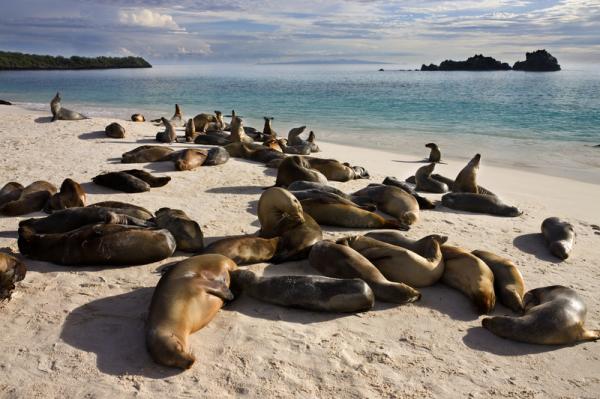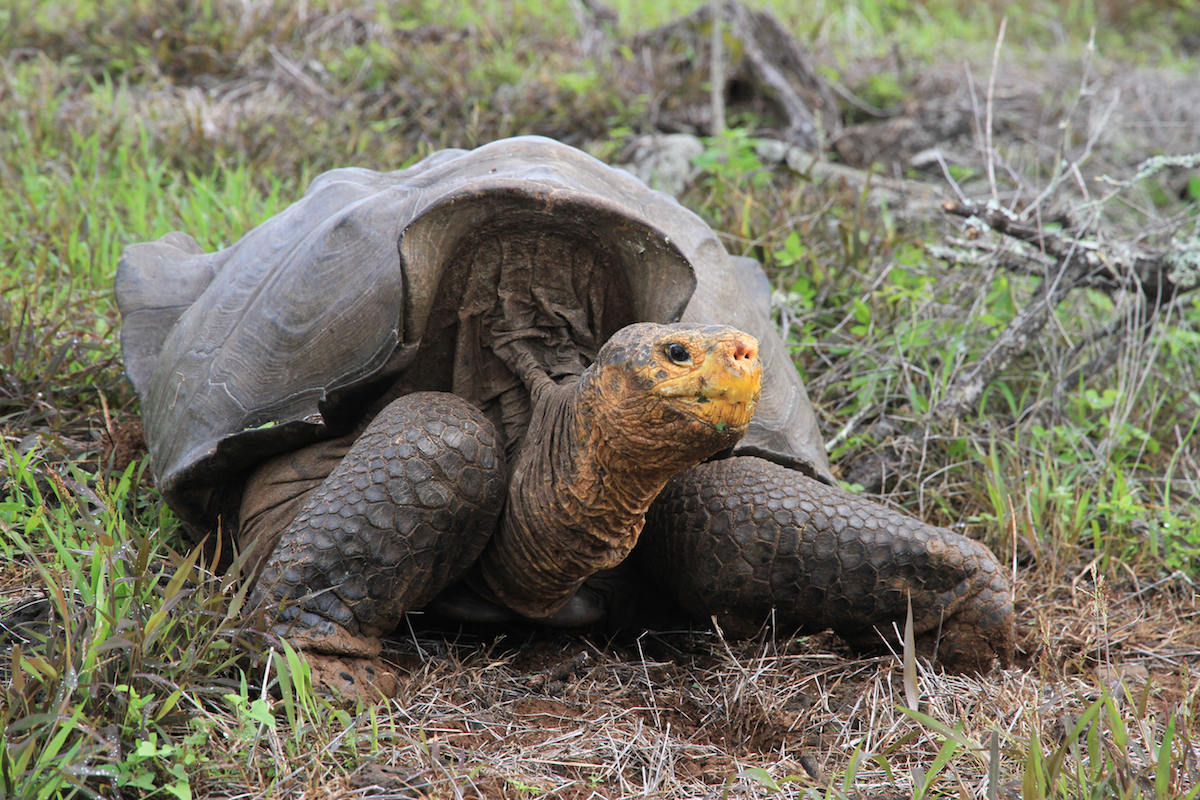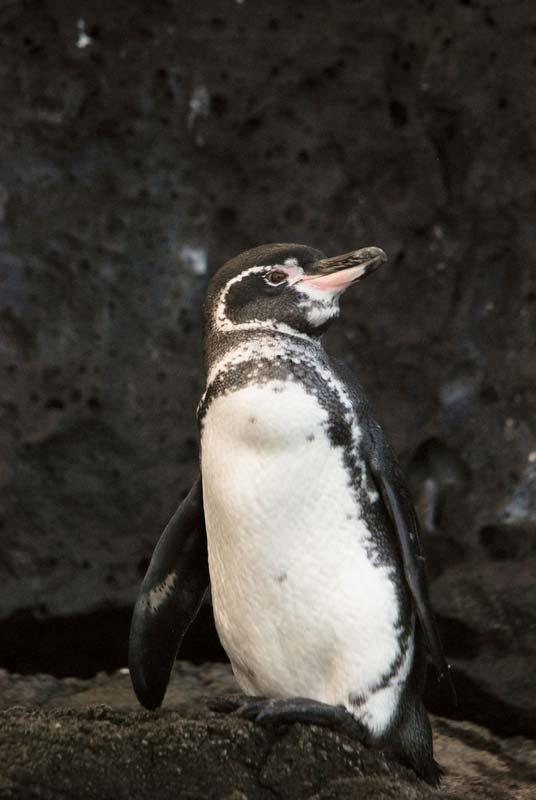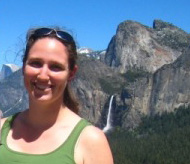The Galápagos Islands: Laboratory of Evolution

The Galápagos Islands archipelago is home to a complex ecosystem with a fascinating geological history, as well as unique examples of plant and animal life. The islands' flora and fauna inspired renowned naturalist Charles Darwin to formulate his theory of evolution, and thousands of tourists and scientists flock to the islands every year to further study the wildlife.
Geography
Thirteen major islands, seven smaller islands and about 125 islets and rocks make up the Galápagos Islands, which lie about 600 miles (1,000 kilometers) off the coast of Ecuador in the Pacific Ocean. Straddling the equator, the islands in the chain are located in both the Northern and Southern hemispheres.
Isabela, the largest island, covers 1,803 square miles (4,670 square km) and reaches an altitude of 5,600 feet (1,707 meters). The smallest of the main islands is South Plaza, with an area of 0.05 square miles (0.13 square km), or about 20 city blocks.
Geology
The Galápagos Islands are volcanic islands located on the Nazca Plate, which is moving to the east-southeast, toward the South American Plate. The meeting of the two tectonic plates has created a subduction zone as the Nazca Plate slides under the South American Plate. The Andes Mountains were created as a result.
As the Nazca Plate passed over the Galápagos hotspot — a point where magma pushes through the crust — volcanoes erupted, and eventually, the Galápagos Islands were formed. It is estimated that the hotspot has been active for at least 20 million years, and that the islands as we see them today formed over the last three to four million years. The movement over the hotspot is evident in the ages of the islands, which increase in roughly the same direction. The oldest islands are Isla Española and South Plaza, which are between 3 million and 4 million years old, according to Volcanic Galapagos. The islands of Darwin, Fernandina, Genovesa, Isabela, Marchena and Santiago are all approximately 700,000 years old.
Many of the volcanoes are still active. Isabela is made up of six distinct volcanoes, Loyc Vanderkluysen, a geoscientist and volcanologist at Drexel University in Philadelphia, told Live Science. Six volcanoes on three separate islands have erupted in the Galápagos since 1990.
Climate
Although they lie within the tropics, the Galápagos Islands don't have lush rainforests. The islands sit in the path of three intersecting major ocean currents, according to Cornell University: The Humboldt (or Peru) Current brings cold waters from Antarctica; the Panama Current is warmer and comes from the north and the Cromwell Current causes deep, cold water to rise to the surface (called upwelling). The cooler waters keep the climate moderate and dry.
The islands experience two seasons each year. The dry season is July through December, when average temperatures are typically in the mid-70s degrees Fahrenheit (mid-20s degrees Celsius) and rainfall averages less than half an inch (a little more than a centimeter) per month. During the dry season, fog is typically found at higher elevations, but there is little rain. The warm season is from January through June, when average temperatures reach the low to mid-80s degrees F (upper 20s to low 30s degrees C) and rainfall reaches a little over an inch (almost 3 cm) per month. March and April are typically the wettest months (receiving 1.5 to 2 inches of rain), with much of the rain draining through the volcanic rock and soil.
Every two to eight years, El Niño brings warmer, less-nutrient-rich waters. Many species suffer during this time as the food chain is disrupted, according to the World Wildlife Fund. The El Niño events of 1982-1983 and 1997-1998 were especially devastating; the marine iguana population declined by about 90 percent, and the penguin population dropped by more than 75 percent. The total population of sea lions declined by about 50 percent, but nearly all sea lions under age 3 perished.
With climate change affecting the severity and frequency of El Niño events, the "new normal" is forecast to be similar to El Niño periods year-round, with warmer air and water and increased rainfalls, according to WWF. Climate change may also cause sea levels to rise and levels of acidity to increase.
Plants
About 600 plants are native to the Galápagos, and at least 30 percent of those are endemic, meaning they're found nowhere else in the world, according to the Galapagos Conservancy.
There are also an estimated 800 introduced species, some of which are incredibly invasive, meaning that they can quickly intrude into the environment and cause harm to native plants and animals. These include quinine, guava and blackberry. A few of the invasive species, such as tropical kudzu, have been successfully eradicated, according to Plantwise.
There are three main vegetation zones in the Galápagos: coastal, arid and humid highlands.
The coastal zone follows the shorelines of the islands, and the mangrove trees that grow there provide shelter and breeding grounds to many birds, iguanas, sea lions and sea turtles. The roots of the trees provide a protected habitat for marine life such as shrimp, crabs and small fish. Other plants that grow in this area include saltbush and beach morning glory, according to The Galapagos Islands handbook.
The arid zone is the largest in the islands and contains many plants typically found in deserts, such as cacti, succulents and leafless shrubs, according to the handbook. This zone extends from near the shoreline up to about 200 feet (60 m) in elevation.
A transitional zone sits between the arid zone and humid highlands. It has characteristics of both the arid and humid zones, with dense vegetation dominated by small trees and shrubs with various types of ferns.
The humid highlands, which start at about 1,000 feet (300 m), feature the scalesia tree and the Miconia robinsoniana shrub, which is considered one of the most endangered plant species on the islands, according to the handbook. These regions have some of the most fertile soil on the islands, and vast portions of these zones have been cleared for agriculture on the human-inhabited islands.
On the few islands that are taller than about 2,000 feet (600 m), the Galápagos tree fern (Cyathea weatherbyana) is the dominant plant.

Animals
The Galápagos are famous for several unique animals, including giant tortoises, iguanas, Darwin's finches and Galápagos penguins. According to the Galapagos Conservancy, about 80 percent of the islands' land birds, 97 percent of the reptiles and land mammals, and at least 20 percent of the marine species are endemic to the islands.
The tortoises in the Galápagos are the largest in the world, with males reaching up to 6 feet (1.8 m) long and more than 550 lbs. (250 kilograms), according to the San Diego Zoo. They live well over a century, with the oldest known tortoise living to approximately 170 years old.
There are an estimated 20,000 to 25,000 giant tortoises in the wild, according to the Galapagos Conservancy with the species as a whole ranked as vulnerable by the WWF. Four species are extinct. Lonesome George, the last surviving member of Chelonoidis abingdoni, the species native to Pinta Island, died in 2012. Threats to the survival of the giant tortoises include invasive species and climate change.
The only marine iguanas in the world — in addition to three land species — are endemic to the Galápagos. Marine iguanas have been known to grow to be up to 4 feet (1.2 m) long; land iguanas grow longer than 3 feet (1 m), according to the Galapagos Conservancy. Marine iguanas live both on land and in the sea, primarily eating in the water and resting and mating on land. They face relatively few predators while in the sea, but on land, both marine and land iguanas may be hunted by hawks, herons and introduced species, such as cats and dogs. Numbers in some locations have dwindled significantly due to introduced species, although due to conservation efforts, populations are considered to be healthy and increasing.
Very few species of mammals are native to the Galápagos Islands: Galápagos sea lions (Zalophus wollebaeki), Galápagos fur seals (Arctocephalus galapagoensis), four species of rice rats (Nesoryzomys narboroughii, Oryzomys bauri, Nesoryzomys swarthy, and Nesoryzomys fernandinae) and two species of bats (Lasiurus cinereus and Lasiurus brachyotis). Dolphins and whales also visit the islands, according to the Galapagos Conservancy.
The Galápagos sea lion is the islands' largest animal, with males weighing up to about 550 lbs. (250 kg). They are often found lounging on the docks and beaches. Sea lions tend to gather in harems consisting of a dominant male and several females, or in bachelor colonies, according to the Galapagos Conservancy.
Galápagos fur seals, which are actually a type of sea lion, prefer the rockier, shadier beaches when they aren't swimming. In the 1800s, the fur seals were hunted nearly to extinction for their insulating coats. The population today has made a dramatic comeback with numbers similar to those of the sea lions, according to the Galapagos Conservancy
Twenty-nine species of land birds live on the islands; 22 of them are endemic species, and four are endemic subspecies. Thirteen of the endemic species are varieties of Darwin's finches, and four are mockingbird species. Eight of the 22 endemic species are considered vulnerable or higher. Two — the mangrove finch and the floreana mockingbird — are critically endangered, according to the Galapagos Conservancy.
Darwin's finches make up the largest population group on the islands. Each of the individual species, as noted by Darwin, has a distinctive beak shape and size depending on their diet. Diets range from seeds, flowers and leaves to insects, including ticks groomed from tortoises and iguanas, as well as the blood of seabirds. Darwin's study of the differences among the finches helped him develop the theories of natural selection and evolution.
There are six endemic species of sea birds: the Galápagos penguin (Spheniscus mendiculus); the flightless cormorant (Phalacrocorax harrisi); the waved albatross (Phoebastria irrorata), the largest of the birds; the Galápagos petrel (Pterodroma phaeopygia), the lava gull (Leucophaeus fuliginosus) and the swallow-tailed gull (Creagrus furcatus), according to the Galapagos Conservancy. Additional species that call the islands home include three species of boobies, great and magnificent frigate birds, and red-billed tropicbirds.

The Galápagos penguin is the only penguin that lives near the equator. The vast majority of the 2,000 penguins live on Fernandina and Isabela islands. The penguin is on the International Union for Conservation of Nature's Red List of Threatened Species, due to its small population size, which fluctuates with El Niño years. According to a 2005 paper in the journal Biological Conservation, the numbers may continue to drop because of increased El Niño events, which cause drastic decreases in the food supply at the start of breeding season, when penguins stock up on as much food as they can.
Among the large populations of marine life living in the waters around the Galápagos, approximately 20 percent of the species are endemic, according to the Galapagos Conservancy. And 544 species of fish have been identified in the protected waters around the islands as of 2016, according to the Darwin Foundation; at least 79 species are endemic, and another 452 are indigenous (native to the Galápagos but also found elsewhere). Of these species, nearly 30 are sharks, including the whale shark (Rhincodon typus) — the largest fish in the world — which reaches up to 40 feet long (12 m) and weighs up to 22 tons (20 metric tons). There are also several types of rays (such as the 20-foot wide giant manta ray) and many tropical fish species, according to Natural Habitat Adventures.
History
Explorer Thor Heyerdahl found pots and other artifacts on the Galápagos in the 1950s, suggesting that South American people had visited the islands in the pre-Columbian era. The first European to visit the Galápagos was Fray Tomás de Berlanga, the Spaniard recently named the bishop of Panama. He accidentally reached the islands in March 1535 after his ship was carried off course, according to Cornell University. De Berlanga opined that there was little value to the islands due to their difficulty in locating fresh water sources, and the limited plant and animal life deemed valuable for humans.
The islands first appeared on world maps by Gerardus Mercator and Abraham Ortelius around 1570, with the name Insulae de los Galopegos (Island of the Tortoises), according to Cornell University.
During the height of the Spanish empire, pirates used the islands as a base for their raids on Spanish ships heading back to Europe. Sir Francis Drake, an explorer commissioned by England with tendencies towards piracy, was the first to use the islands in this way in 1578, according to the Galapagos Conservancy.
By the end of the 18th century, whalers began to replace the pirates. Besides whales, whalers also hunted tortoises, birds and fur seals, leading some species into extinction or close to it, according to Cornell. It is estimated that nearly 200,000 tortoises were hunted in the 19th century alone, and the fur seals were nearly extinct by the end of the century.
During the War of 1812, the USS Essex, commanded by Capt. David Porter, reached the islands and nearly decimated the British whaling fleet. Porter also wrote detailed notes about the islands, including descriptions of the eruption of Floreana in 1813 and some differences in the types of giant tortoises, as well as carefully charted the islands' coastlines, according to the Galapagos Conservancy.
The first European resident of the Galápagos was Patrick Watkins, an Irishman, who arrived on the island of Floreana in 1805, living in a drunken state for nearly his entire stay, according to the Galapagos Conservation Trust. He escaped to Ecuador in 1809 after trapping a handful of men on the islands with him and stealing a boat. Watkins, however, landed alone after most likely killing his crew on the voyage. Although he had planned to return to the islands, it is unlikely that he ever did, as it is rumored he was thrown in jail just before his boat launched. "Moby Dick" author Herman Melville, who was a whaler for several years, visited the islands in 1841 and used Watkins as his inspiration for a part in his short story "Las Encantadas" (The Enchanted Islands), which was published in 1854.
Colonization of the islands began in the early 1830s, according to the Galapagos Conservancy. Ecuadoran Gen. José María de Villamil brought over colonists, who were primarily soldiers, to the island of Floreana. About 15 years later, the settlement was deemed a failure. Two additional attempts to colonize Floreana occurred in 1858 and in 1893.
According to the Galapagos Conservancy, in the 1920s, Norwegian settlers landed in Floreana, San Cristóbal and Santa Cruz islands. Originally, they were looking to set up whaling facilities but switched over to a fishing and cannery business. German colonists began arriving in 1929 to work with the Norwegian farmers and fishermen.
Penal colonies were set up on Floreana and San Cristóbal in the mid-19th century and on Isabela in the 1940s, according to the Galapagos Conservancy. The penal colonies were closed in 1959 after a rebellion in 1958 at the Isabela prison.
In 1959, the vast majority of the land area — 97 percent — was designated a protected national park, according to the United Nations Educational, Scientific and Cultural Organization(UNESCO). Four of the islands — Floreana, Isabela, San Cristóbal and Santa Cruz — have a total permanent population of about 25,000 people, who are restricted to the remaining 3 percent of total land area across the islands.
Darwin and evolution
Credited as the father of evolution, Darwin was actually a trained geologist. Darwin had been traveling around South America for about four years before landing in the Galápagos in 1835, J. Bret Bennington, chair of the Department of Geology, Environment, and Sustainability at Hofstra University, told Live Science. During that time, Darwin became familiar with the plant and animal life that lived in various climates around the mainland as well as with some of the islands the ship visited in the Atlantic Ocean on its way to South America from England, said Bennington, who also directs a study abroad program to the Galápagos Islands.
Darwin was a creationist when he began his journey on the HMS Beagle, but he slowly changed his mind during the voyage, especially when he studied life on and around the Galápagos. Darwin saw many islands of various sizes, close together and geologically young inhabited by similar yet different species of plant and animal life. Darwin concluded that life in the Galápagos didn't make sense with the current views of creationism.
It took Darwin 23 years after returning home from his voyage to put together the jigsaw puzzle that fully supported evolution and natural selection, which is one of bases of evolution that explains why certain traits get passed on to the following generations, according to the University of California at Berkeley. Published in 1859, Darwin's famous "On the Origin of Species" took the foundations for the theories of evolution that had already been placed before him and built upon them, providing the evidence that definitively supported evolution. Within a decade of the theories' publication, according to Cornell, scientists favored Darwin's theories of evolution and natural selection over creationism, and these transformational ideas still hold today, about 160 years later.
Environmental threats and conservation efforts
According to UNESCO, the primary threats to the Galápagos are invasive plant and animal species, increased tourism, demographic growth, illegal fishing and governance issues. Global warming is another threat that is beginning to affect the islands, according to National Geographic.
According to the Convention on Biological Diversity (CBD), there is an equilibrium in any isolated habitat, such as an island, that affects species diversity, which is maintained between the rates of increased species types and populations, and extinction. Invasive plant and animal species can be introduced into the environment by humans or via air or water; the invaders can upset the natural equilibrium and thus greatly increase the extinction rate of native plants and animals.
The spread of invasive species is slowed through prevention measures, according to the CBD. Education of the local population and any travelers to the islands is key to making informed decisions on how to slow and eradicate species in order to help bring the native ecosystem back to its natural equilibrium.
Illegal fishing is also a major threat to the ecosystem. A 2014 article in the journal Aquatic Conservation: Marine And Freshwater Ecosystems noted that fishing for sharks simply for their fins, for example, creates an imbalance in the ecosystem: The populations of other predatory species, such as sea lions, will increase, leading to an increased consumption of fish, many of which are commercially valuable. The imbalance eventually leads to an environment that is unsustainable for both predator and prey. The researchers recommended that the existing rules governing fishing around the islands be further enforced, and that loopholes, such as the one allowing the fishing of sharks in certain instances, be closed in order to maintain the islands' natural biodiversity and health.
Dr. Jeffrey Roberg, chair of political science at Carthage College in Wisconsin and who researches environmental politics in South America, believes that tourists are the primary invasive species disrupting the natural equilibrium of the islands. Even when being as careful as possible, tourists can have negative effects on the environment. This can be true even though paying tourists are a source of funding for conservation efforts, Roberg said. Even with rules in place, more tourists mean more opportunity for abusing those rules, he added.
According to the Galápagos Conservatory, as of 2015, there were 291 authorized hotels and 74 cruise vessels with onboard accommodation housing the nearly 250,000 tourists who visited the islands annually. There is currently no limit on the number of tourists who can visit the islands. The number of tourists is forecast to rise steadily over the next several years unless laws are put into place and enforced.
Increased tourism brings increased foot traffic and, therefore, increased potential for tourists to go off the designated paths, which could disrupt local wildlife. More tourists mean more supplies need to be brought in, such as potable water and building materials for additional hotels, shops and residences. Also, the potential increases for accidents that can affect the environment, such as a large oil spill that occurred in 2001, according to Roberg. And there is also the issue of what to do with the additional trash that would be produced with growing numbers of tourists, as well as the treatment of additional liquid and solid waste.
Even when tourists primarily live and sleep on boats, Roberg said, the light from the boats attract insects at night, and then these insects have been transported to other islands, where they may not be indigenous. These species can in turn become an invasive species wrecking havoc to other ecosystems, similarly to the behavior of invasive species brought to the Galápagos Islands.
When visiting the islands, Bennington told Live Science, respecting the rules keeps the islands in their relatively pristine condition. A trip to the Galápagos is always an adventure, he added. There is always something new and exciting, like "bow-riding dolphins, a school of sharks, mating giant tortoises, flocks of plunge-diving blue-footed boobies — you just can't anticipate what spectacle nature will present," Bennington said.
Sign up for the Live Science daily newsletter now
Get the world’s most fascinating discoveries delivered straight to your inbox.

Rachel Ross is a science writer and editor focusing on astronomy, Earth science, physical science and math. She holds a Bachelor of Arts in Philosophy from the University of California Davis and a Master's degree in astronomy from James Cook University. She also has a certificate in science writing from Stanford University. Prior to becoming a science writer, Rachel worked at the Las Cumbres Observatory in California, where she specialized in education and outreach, supplemented with science research and telescope operations. While studying for her undergraduate degree, Rachel also taught an introduction to astronomy lab and worked with a research astronomer.










